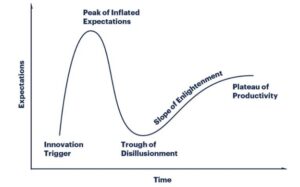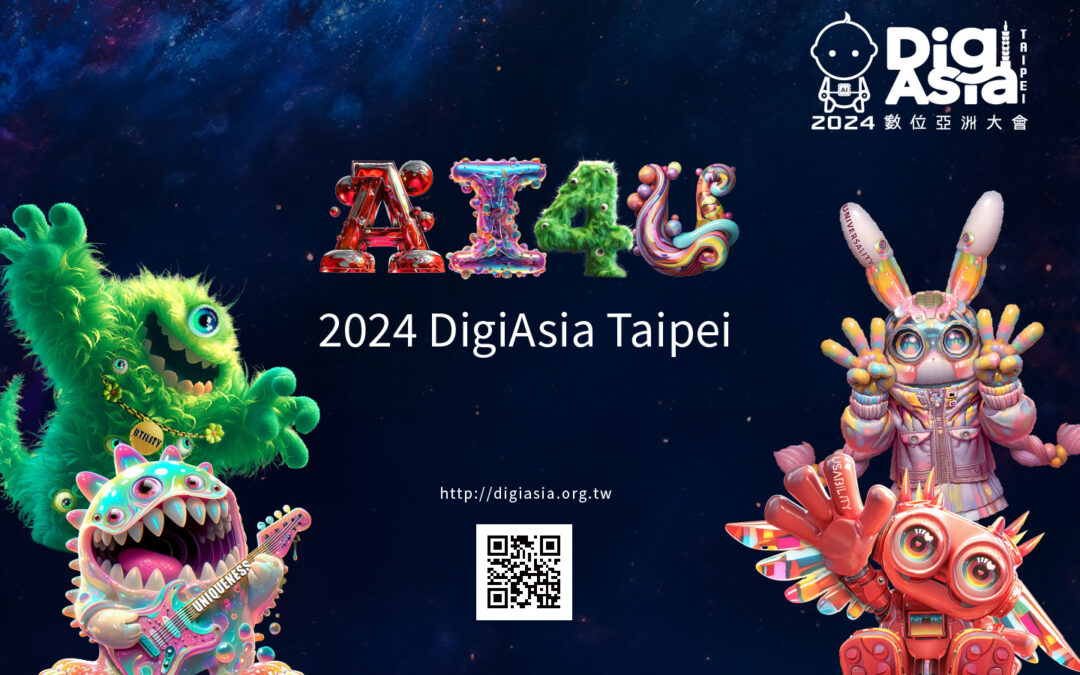DigiAsia 2024 in Taipei brought together tech giants, media and creative agency conglomerates, academia, and Asian companies with AI expertise to showcase the latest developments in generative AI (Gen AI) research and application. The event highlighted case studies on using AI in creative campaigns, across the marketing ecosystem, to solve business problems, and in various aspects of business operations—truly reflecting the conference theme, AI4U.
According to a Gartner report, Gen AI has passed its hype phase and is expected to become a normalized technology within the next 2–5 years. AI is now embedded in phones, computers, and nearly every software we use daily, both for personal and professional tasks. As the initial excitement wanes, we’ve grown aware of AI’s limitations and can readily spot AI-generated writing and imagery.

Garner Hype Cycle on AI (2024)
Key Takeaways
In addition to updates on Gen AI (which now processes audio and video alongside text) and its use in creative campaigns to create personalized experiences or optimize media buys, here are a few key takeaways:
- AI is Blurring the Lines Between Advertising and Media Agencies
Media companies are increasingly offering creative capabilities, as demonstrated in several conference presentations:- Omnicom’s AI platform offers faster content creation, cost efficiency through automation, real-time campaign optimization, and comprehensive consumer insights, driven by strategic partnerships with major tech companies like Google, Amazon, and Adobe.
- Yahoo provides an all-in-one creative suite that helps advertisers create, customize, and optimize content more efficiently. It integrates various AI-powered tools, enabling brands to deliver personalized, high-quality ads at scale.
- Dan Epstein of CNN International shared branded content examples, including a collaboration with Samsung to address microplastic pollution and a project with Hyundai showcasing bi-directional electric vehicle charging.
- Data as a Strategic Asset: Focus on Outcomes, Not Models
With third-party cookies disappearing, first-party data is becoming ever more critical, and AI excels at analyzing large datasets, identifying clusters, and creating predictive models. Ashwini Asokan’s presentation, “The Inmates Are Running the Asylum: A Commentary on the State of AI in 2024,” emphasized that companies with vast proprietary data can leverage AI for personalized solutions and better outcomes. However, success lies not in the models themselves, but in the outcomes they deliver. The focus should be on solving specific problems and achieving tangible results, rather than being sidetracked by the complexity of AI models. - Trust Issues in the Age of Gen AI: The Growing Importance of Authentic Storytelling
A Yahoo study found that while 77% of advertisers view AI positively for enhancing creative development and campaign performance, only 38% of consumers feel the same. This highlights the need for transparency and authenticity in AI-generated content to build consumer trust. - Balancing Content Creation, Distribution, and Marketing
Alex Yong-tae Kim of SMC discussed the differences between traditional and social media agencies. Traditional agencies focus on large-scale, TV-based campaigns with slower, structured processes, while SMC leverages real-time, personalized content on social media platforms. SMC integrates AI and influencer-driven marketing for more agile campaigns, emphasizing user-generated content and personalization to engage niche audiences and build long-term value through dedicated fan bases.
The Future of AI and Advertising
Many presentations explored the future of marketing, advertising, and media buying. Here are insights from some of the speakers:
- Kim Marchan, The Trade Desk: “Step into the Future of Media Buying: Where AI and Humans Collaborate”
AI will optimize campaigns in real time, but human oversight will remain essential to ensure alignment with business objectives. The best outcomes will come from human-AI collaboration, not autonomous AI. - Ayush Agrawal, Wavemaker – GroupM: “The Future of Advertising: AI & Personalization”
Brands must deliver more personalized and impactful experiences, powered by data and AI technology. - Christopher Brewer, Ogilvy Consulting, Asia: “AI—Beyond the Hype”
The greatest business value lies in predictive AI, which enables personalization, optimization, forecasting, and recommendation engines. Companies should focus on high-feasibility, high-value use cases rather than getting distracted by the buzz around generative AI. - Naho Manabe, Hakuhodo Inc.: “How Can We Edit Data with AI to Extend Our Creations into More Attractive Ones?”
AI will continue evolving as a creative collaborator in graphic design, video production, and marketing strategies. Its ability to process vast amounts of data will be key in helping businesses stay competitive and innovative in the rapidly changing digital landscape. - Jason Yeh, MediaTek Inc.: “Productivity & Innovation—MediaTek DaVinci GenAI Platform”
Yeh envisions a future where each employee has an AI assistant, a virtual secretary that handles tasks like scheduling, report generation, and project management, with the ability to understand natural language and interact with other systems seamlessly.
One presentation that particularly resonated with me was Naoki Tanaka’s (Dentsu Lab) on how AI can solve social issues. He drew inspiration from Kintsugi, the Japanese art of mending broken objects with gold, embracing imperfections, and turning them into something beautiful. Tanaka views innovation similarly embracing constraints and imperfections leads to more creative, breakthrough solutions.

Naoki Tanaka drawing analogy of innovation to Kintsugi
Final Thought: Addressing AI Bias
While the limitations and biases of AI are widely acknowledged, there’s little discussion on how to address them. In market research, it’s garbage in, garbage out. Gen AI simply scales up the input and output. This is especially troubling regarding the representation of minority consumers. The representation issues that have persisted in media and marketing prior to Gen AI are only exacerbated by it. As marketers strive for scale and speed with Gen AI, it’s essential to conduct primary research with real people to validate hypotheses, messaging, and media plans.
For comprehensive summaries of the DigiAsia 2024 presentations, please click here.

